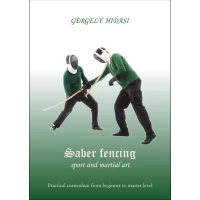Beschrijving
About Stockholm Manual on Sabre Fencing, 1893
Near the end of the 19th century, the Swedish military desired a new manual about sabre fencing. This resulted in the 1893 manual, Instruktion I sabelfäktning till fots (Manual on Sabre Fencing on Foot), most likely penned by the famed military leader, “the father of Swedish sports,” Viktor Balck, and illustrated by his equally famous acquaintance, the renowned wildlife painter Bruno Liljefors.
The system described in the manual is rooted in the basics seen throughout the European fencing systems of the time, yet it also deviates from them in intriguing ways and advocates for approaches that are rather unique. In addition, the text sheds light on historical training methodology by describing how lessons were directed and by presenting images of training tools.
Until now, the Swedish military sabre system has not been particularly accessible to a wider audience due to a lack of English language materials and translations. This book will be one of the first such resources about this intriguing approach to sabre fencing, with a clear and understandable translation that will be useful in the fencing hall.
About the author
When he first tried his hand at historical fencing at Tampere HEMA, Pentti Koivuniemi was instantly enamoured with the combination of practical training and period-source study that form the basis of these martial arts. Pentti majored in English with a specialisation in translation at Tampere University while continuing to study historical fencing, and so, gradually, he felt compelled to translate European martial arts texts for the international community.
Book Details
- Authors: Pentti Koivuniemi
- Editor: Keith Farrell
- Publisher: Fallen Rook Publishing
- Date of Publication: 6th July 2021
- ISBN: 978-1-913066-01-7
- Binding: Paperback
- Pages: 177
- Height: 21.0 cm
- Width: 14.8 cm
- Language: English
Table of Contents
- Introduction
- About the authors
- About the translation
- Bibliography
- Manual on Sabre Fencing on Foot
- CHAPTER I: Basic concepts
- 1. General considerations
- 2. Target area and striking points
- 3. Measure
- 4. On being covered and being exposed
- 5. Lines and sides
- CHAPTER II: Formations, standing in guard, stomping, changing guard, etc.
- 6. Organisation and formations
- 7. Handling of the sabre
- 8. The guard
- 9. Preparatory lessons for standing in guard
- 10. Standing at ease
- 11. Stomps
- 12. Changing guard
- CHAPTER III: Marches and lunges
- 13. Marches
- 14. Lunges on-line, with and without marches, and the movements of the body while defending against them
- 15. Lunges off-line, and the movements of the body while defending against them
- 16. The turns and movements of the body while defending against off-line lunges
- 17. Chasing marches and the movements of the body while defending against them
- CHAPTER IV: Cuts and thrusts
- 18. General rules
- 19. Breakdown of cuts and thrusts
- 20. Single cuts
- 21. Thrusts
- 22. Combined cuts and thrusts
- 23. Compound attacks
- CHAPTER V: Parries
- 24. General rules
- 25. Breakdown of parries
- 26. Single parries
- 27. Compound parries
- CHAPTER VI: Ripostes and counter attacks
- 28. General rules
- CHAPTER VII: Attacking while the blades are bound
- 29. Forced thrusts
- CHAPTER VIII: Preparing strikes and follow-up strikes, persisting strikes
- 30. General rules
- CHAPTER IX: Single and combined strikes and thrusts with marches and lunges
- 31. General rules
- CHAPTER X: Tempo strikes (tempo cuts, tempo thrusts)
- 32. General rules
- 33. A turn of the body with a prim strike as a tempo strike
- 34. A lunge or turn of the body with a tempo thrust
- CHAPTER XI: Free fencing and fencing between different weapons
- 35. Introduction to free fencing (lessons on striking at the opponent)
- 36. Free fencing
- 37. Fencing between different weapons
- CHAPTER XII: Weapons and fencing equipment
- 38. Gymnasium sabre
- 39. Fencing mask
- 40. Plastron
- 41. Fencing gloves
- 42. Pell
- CHAPTER XIII: The arrangement and leading of the lessons
- 43. General rules
- 44. Individual and joint instruction
- 45. Command words
- CHAPTER I: Basic concepts









